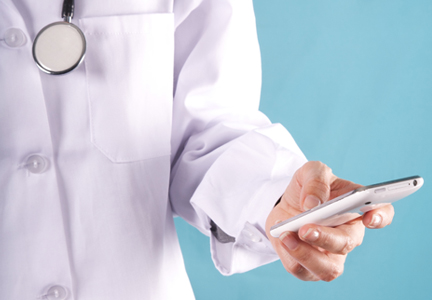User login
Dropbox
What is it?
Dropbox is a replacement for the USB flash drive. Files placed in a Dropbox folder are stored on a server, which allows files on one device to be instantaneously accessible to all your devices that have the Dropbox application installed. Dropbox automatically backs up and synchronizes any changes you make to your files, giving you access to your most up-to-date revisions. Many other mobile applications synchronize data through Dropbox making it a must-have app for any mobile device user.
How does it work?
After creating an account and downloading the application on your computer and mobile devices, a folder will be created on your hard drive called “Dropbox.” Any files you place in the Dropbox folder are automatically synchronized across all your computers and mobile devices. Any changes you make to a file in the Dropbox folder also are automatically synchronized across all your devices. Any mistakes you make can be corrected because Dropbox saves a file revision history, allowing you to recover any prior version of all your files. Folders within Dropbox also can be shared with colleagues.
All files are encrypted on Dropbox using the 256-bit Advanced Encryption Standard and sent over the Internet between your devices using a secure channel that uses Secure Sockets Layer encryption. This level of security is the same encryption standard used by banks to secure customer data. Data is stored using Amazon’s Simple Storage Service (S3), which uses military-grade perimeter control beams, video surveillance, and professional security staff, according to Amazon, to maintain physical security of your data.
The user interface in the mobile Dropbox application is simple. There is a left pane showing stored files and a right pane showing individual file contents (ie, text, images, slideshows, music, movies). The left pane has 6 buttons, allowing you to upload files, delete files, view files, view photographs, mark files as favorites, and enter the settings pane. The right pane has 3 buttons, allowing you to share the viewed file, mark the viewed file as a favorite, and open the file in an alternate program (eg, another text-editing app, presentation app, music app).
How can it help me?
I use Dropbox to keep my important files with me at all times. A particularly useful feature is the star-shaped Favorites button, which allows me to temporarily download files to my mobile device’s RAM before going on plane trips or being in other areas that may not provide Internet access, that way I can work on a paper or presentation during my flight and be assured that all my work will be stored online and synchronized as soon as my device regains Internet access.
I also use Dropbox to share large files, such as presentations, movies, and photograph albums. The Share button can be used to e-mail friends and colleagues a link to files that are too large to send by e-mail. Because promiscuous USB drives are a source of malware, I also use Dropbox to share small and large files with computers of unknown security; if I do not know that a computer is free of spyware and viruses, I assume it is infected.
How can I get it?
Dropbox can be downloaded from the Apple App Store for your iPhone, iPod Touch, and/or iPad; the Google Play Store; or the product Web site. A free account provides 2 to 18 GB, but if you need more storage, there are Pro and Business accounts that offer more than 100 GB starting at $9.99/month.
For more information, go to www.dropbox.com.
What is it?
Dropbox is a replacement for the USB flash drive. Files placed in a Dropbox folder are stored on a server, which allows files on one device to be instantaneously accessible to all your devices that have the Dropbox application installed. Dropbox automatically backs up and synchronizes any changes you make to your files, giving you access to your most up-to-date revisions. Many other mobile applications synchronize data through Dropbox making it a must-have app for any mobile device user.
How does it work?
After creating an account and downloading the application on your computer and mobile devices, a folder will be created on your hard drive called “Dropbox.” Any files you place in the Dropbox folder are automatically synchronized across all your computers and mobile devices. Any changes you make to a file in the Dropbox folder also are automatically synchronized across all your devices. Any mistakes you make can be corrected because Dropbox saves a file revision history, allowing you to recover any prior version of all your files. Folders within Dropbox also can be shared with colleagues.
All files are encrypted on Dropbox using the 256-bit Advanced Encryption Standard and sent over the Internet between your devices using a secure channel that uses Secure Sockets Layer encryption. This level of security is the same encryption standard used by banks to secure customer data. Data is stored using Amazon’s Simple Storage Service (S3), which uses military-grade perimeter control beams, video surveillance, and professional security staff, according to Amazon, to maintain physical security of your data.
The user interface in the mobile Dropbox application is simple. There is a left pane showing stored files and a right pane showing individual file contents (ie, text, images, slideshows, music, movies). The left pane has 6 buttons, allowing you to upload files, delete files, view files, view photographs, mark files as favorites, and enter the settings pane. The right pane has 3 buttons, allowing you to share the viewed file, mark the viewed file as a favorite, and open the file in an alternate program (eg, another text-editing app, presentation app, music app).
How can it help me?
I use Dropbox to keep my important files with me at all times. A particularly useful feature is the star-shaped Favorites button, which allows me to temporarily download files to my mobile device’s RAM before going on plane trips or being in other areas that may not provide Internet access, that way I can work on a paper or presentation during my flight and be assured that all my work will be stored online and synchronized as soon as my device regains Internet access.
I also use Dropbox to share large files, such as presentations, movies, and photograph albums. The Share button can be used to e-mail friends and colleagues a link to files that are too large to send by e-mail. Because promiscuous USB drives are a source of malware, I also use Dropbox to share small and large files with computers of unknown security; if I do not know that a computer is free of spyware and viruses, I assume it is infected.
How can I get it?
Dropbox can be downloaded from the Apple App Store for your iPhone, iPod Touch, and/or iPad; the Google Play Store; or the product Web site. A free account provides 2 to 18 GB, but if you need more storage, there are Pro and Business accounts that offer more than 100 GB starting at $9.99/month.
For more information, go to www.dropbox.com.
What is it?
Dropbox is a replacement for the USB flash drive. Files placed in a Dropbox folder are stored on a server, which allows files on one device to be instantaneously accessible to all your devices that have the Dropbox application installed. Dropbox automatically backs up and synchronizes any changes you make to your files, giving you access to your most up-to-date revisions. Many other mobile applications synchronize data through Dropbox making it a must-have app for any mobile device user.
How does it work?
After creating an account and downloading the application on your computer and mobile devices, a folder will be created on your hard drive called “Dropbox.” Any files you place in the Dropbox folder are automatically synchronized across all your computers and mobile devices. Any changes you make to a file in the Dropbox folder also are automatically synchronized across all your devices. Any mistakes you make can be corrected because Dropbox saves a file revision history, allowing you to recover any prior version of all your files. Folders within Dropbox also can be shared with colleagues.
All files are encrypted on Dropbox using the 256-bit Advanced Encryption Standard and sent over the Internet between your devices using a secure channel that uses Secure Sockets Layer encryption. This level of security is the same encryption standard used by banks to secure customer data. Data is stored using Amazon’s Simple Storage Service (S3), which uses military-grade perimeter control beams, video surveillance, and professional security staff, according to Amazon, to maintain physical security of your data.
The user interface in the mobile Dropbox application is simple. There is a left pane showing stored files and a right pane showing individual file contents (ie, text, images, slideshows, music, movies). The left pane has 6 buttons, allowing you to upload files, delete files, view files, view photographs, mark files as favorites, and enter the settings pane. The right pane has 3 buttons, allowing you to share the viewed file, mark the viewed file as a favorite, and open the file in an alternate program (eg, another text-editing app, presentation app, music app).
How can it help me?
I use Dropbox to keep my important files with me at all times. A particularly useful feature is the star-shaped Favorites button, which allows me to temporarily download files to my mobile device’s RAM before going on plane trips or being in other areas that may not provide Internet access, that way I can work on a paper or presentation during my flight and be assured that all my work will be stored online and synchronized as soon as my device regains Internet access.
I also use Dropbox to share large files, such as presentations, movies, and photograph albums. The Share button can be used to e-mail friends and colleagues a link to files that are too large to send by e-mail. Because promiscuous USB drives are a source of malware, I also use Dropbox to share small and large files with computers of unknown security; if I do not know that a computer is free of spyware and viruses, I assume it is infected.
How can I get it?
Dropbox can be downloaded from the Apple App Store for your iPhone, iPod Touch, and/or iPad; the Google Play Store; or the product Web site. A free account provides 2 to 18 GB, but if you need more storage, there are Pro and Business accounts that offer more than 100 GB starting at $9.99/month.
For more information, go to www.dropbox.com.
Read by QxMD
What is it?
Rather than opening up a different journal app for each individual subscription or searching through multiple journals online, Read by QxMD collects articles related to your interests from all your favorite journals and creates a virtual personalized journal. It is my favorite app for staying current with dermatology literature.
How does it work?
When you enter this app for the first time, it asks for a username and password to obtain proxy access to your institutional library. (For security, the username and password are encrypted on the mobile device before authenticating the user. This information is not shared with QxMD staff.) The app then asks you to select journals and specialties to follow. That is it; you are ready to use the app.
The user interface is very easy to understand. There is an upper toolbar with 6 buttons that allows you to browse articles by (1) articles featured for you based on your initial setup, (2) journals preselected by you, (3) collections selected by the app, (4) new topics you wish to explore, (5) stored favorite articles selected by you, and (6) a basic search engine. A seventh button allows you to change your settings. Below the toolbar are articles.
Browsing articles also is very easy, as individual papers are arranged as a mosaic created to resemble browsing through a magazine. The title of each article followed by a summary (usually an abstract) is displayed. To see more articles, you “flip” the page with your finger. Clicking on an article brings up the entire abstract and options to download the PDF, store it as a favorite, or share the article with a friend. Downloaded PDFs are presented in a PDF editor with basic highlighting and annotating functions. If you need additional capabilities, there is a button for exporting articles to other PDF readers.
How can it help me?
I use Read by QxMD to stay up-to-date with dermatologic literature when I have limited windows of downtime, such as drinking my morning cup of coffee or waiting in lines; while other people are playing Angry Birds, this app allows me to get work done! The personalization and magazine-style presentation are enjoyable as I’m keeping up with dermatologic literature. I would not use this app as a point-of-care decision support tool, a journal article storage tool, or PDF editor, as there are better apps designed for those processes. I also suggest limiting the journals and specialties you follow to those you are highly interested in or you will become overwhelmed scanning through articles that are only somewhat interesting to you.
How can I get it?
Because Read by QxMD is free, every dermatologist should try this mobile app.
It is available in the Apple App Store for your iPod Touch, iPad, and/or iPhone.
For a list of participating institutions, go to www.qxmd.com.
What is it?
Rather than opening up a different journal app for each individual subscription or searching through multiple journals online, Read by QxMD collects articles related to your interests from all your favorite journals and creates a virtual personalized journal. It is my favorite app for staying current with dermatology literature.
How does it work?
When you enter this app for the first time, it asks for a username and password to obtain proxy access to your institutional library. (For security, the username and password are encrypted on the mobile device before authenticating the user. This information is not shared with QxMD staff.) The app then asks you to select journals and specialties to follow. That is it; you are ready to use the app.
The user interface is very easy to understand. There is an upper toolbar with 6 buttons that allows you to browse articles by (1) articles featured for you based on your initial setup, (2) journals preselected by you, (3) collections selected by the app, (4) new topics you wish to explore, (5) stored favorite articles selected by you, and (6) a basic search engine. A seventh button allows you to change your settings. Below the toolbar are articles.
Browsing articles also is very easy, as individual papers are arranged as a mosaic created to resemble browsing through a magazine. The title of each article followed by a summary (usually an abstract) is displayed. To see more articles, you “flip” the page with your finger. Clicking on an article brings up the entire abstract and options to download the PDF, store it as a favorite, or share the article with a friend. Downloaded PDFs are presented in a PDF editor with basic highlighting and annotating functions. If you need additional capabilities, there is a button for exporting articles to other PDF readers.
How can it help me?
I use Read by QxMD to stay up-to-date with dermatologic literature when I have limited windows of downtime, such as drinking my morning cup of coffee or waiting in lines; while other people are playing Angry Birds, this app allows me to get work done! The personalization and magazine-style presentation are enjoyable as I’m keeping up with dermatologic literature. I would not use this app as a point-of-care decision support tool, a journal article storage tool, or PDF editor, as there are better apps designed for those processes. I also suggest limiting the journals and specialties you follow to those you are highly interested in or you will become overwhelmed scanning through articles that are only somewhat interesting to you.
How can I get it?
Because Read by QxMD is free, every dermatologist should try this mobile app.
It is available in the Apple App Store for your iPod Touch, iPad, and/or iPhone.
For a list of participating institutions, go to www.qxmd.com.
What is it?
Rather than opening up a different journal app for each individual subscription or searching through multiple journals online, Read by QxMD collects articles related to your interests from all your favorite journals and creates a virtual personalized journal. It is my favorite app for staying current with dermatology literature.
How does it work?
When you enter this app for the first time, it asks for a username and password to obtain proxy access to your institutional library. (For security, the username and password are encrypted on the mobile device before authenticating the user. This information is not shared with QxMD staff.) The app then asks you to select journals and specialties to follow. That is it; you are ready to use the app.
The user interface is very easy to understand. There is an upper toolbar with 6 buttons that allows you to browse articles by (1) articles featured for you based on your initial setup, (2) journals preselected by you, (3) collections selected by the app, (4) new topics you wish to explore, (5) stored favorite articles selected by you, and (6) a basic search engine. A seventh button allows you to change your settings. Below the toolbar are articles.
Browsing articles also is very easy, as individual papers are arranged as a mosaic created to resemble browsing through a magazine. The title of each article followed by a summary (usually an abstract) is displayed. To see more articles, you “flip” the page with your finger. Clicking on an article brings up the entire abstract and options to download the PDF, store it as a favorite, or share the article with a friend. Downloaded PDFs are presented in a PDF editor with basic highlighting and annotating functions. If you need additional capabilities, there is a button for exporting articles to other PDF readers.
How can it help me?
I use Read by QxMD to stay up-to-date with dermatologic literature when I have limited windows of downtime, such as drinking my morning cup of coffee or waiting in lines; while other people are playing Angry Birds, this app allows me to get work done! The personalization and magazine-style presentation are enjoyable as I’m keeping up with dermatologic literature. I would not use this app as a point-of-care decision support tool, a journal article storage tool, or PDF editor, as there are better apps designed for those processes. I also suggest limiting the journals and specialties you follow to those you are highly interested in or you will become overwhelmed scanning through articles that are only somewhat interesting to you.
How can I get it?
Because Read by QxMD is free, every dermatologist should try this mobile app.
It is available in the Apple App Store for your iPod Touch, iPad, and/or iPhone.
For a list of participating institutions, go to www.qxmd.com.



